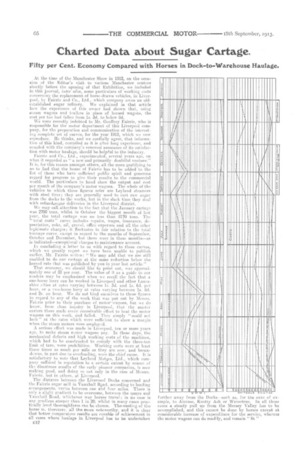Charted Data about Sugar Cartage.
Page 16

If you've noticed an error in this article please click here to report it so we can fix it.
Fifty per Cent. Economy Compared with Horses in Dock-to-Warehouse Haulage.
At the time of the Manchester Show in 1912, on the occasion of the Editor's visit to various Manchester centres shortly before the opening of that Exhibition, we included in this journal, inter cilia, some particulars of working costs concerning the replacement of horse-drawn vehicles, in Liverpool, by Fairrie and Co., Ltd., which company owns an oldeatablished sugar refinery. We explained in that article how the experience of this owner had shown that, using steam wagons and trailers in place of horsed wagons, the cost per ton had fallen from is. 3d. to below 8d.
We were recently indebted to Mr. Geoffrey Fairrie, who is responsible for the motor department of this Liverpool company, for the preparation and communication of the interesting complete set of curves, for the year 1912, which we now reproduce. He thinks, and we cordially agree, that information of this kind, compiled as it is after long experience, and coupled with the company's renewed assurance of its satisfaction with motor haulage, should be helpful to the industry. Fairrie and Co., Ltd., experimented, several years ago, on what it regarded as a new and primarilydoubtful venture." It is, for this reason amongst others, all the more gratifying to us to find that the house of Fairrie has to be added to the list of those who have sufficient public spirit and generous regard for progress to give their results to the commercial world. The particulars to hand show the output and cost per month of the company's motor wagons. The whole of the vehicles to which these figures refer are Leyland steamers with steel tires ; they slIT generally used to cart raw sugar from the docks to the works, but in the slack time they deal with refined.sugar deliveries in the Liverpool district.
We may call attention to the fact that the January cartage was 2700 tons, whilst in October the biggest month (if last year, the total cartage was no less than 8170 tons. The " total costs " curve includes repairs, wages, insurance, depaeciation, coke, oil, gravel, office expenses and all the other legitimate charges ; it fluctuates in fair relation to the total tonnage curve, except in regard to the months of September, October and December, hut there were in these months—as is indicated—eweptional charges to maintenance account.
In concluding a letter to us with regard to these curves, which we greatly regret we have been unable to publish earlier, Mr. Fairrie writes: " We may add that we are still enabled to do our cartage at the same reduction below the horsed rate that was published by you in your last article." That economy, we should like to point out, was approximately one of 50 per cent. The value of it as a guide to our readers may be emphasized when we recall the fact that a one-horse lorry can be worked in Liverpool and other Lancashire cities at rates varying between Is. 3d. and 1s. 6d. per hour, or a two-horse lorry at rates varying between 1s. 8d. and 2s. an hour. We do not bintd, ourselves to these figures in regard to any of the work that was putout by Messrs. Fairrie prior to their purchase of motor wagons, but we do know, from close inquiry in Liverpoul, that the master carters there made every conceivable effort to beat the motor wagons on this work, and failed. They simply " could not look " at the rates which were sufficient to show a margin when the steam motors were employ-rd. A serious effort was made in Liverpool, ten or more years ago, to make steam motor wagons pay. In those days, the mechanical defects and high working costs of the machines, which had to be constructed to comply with the three-ton limit of tare, were prohibitive. Working costs were at least three times as much per mile as they are now, arid breakdawns. in part doe to overloading, were the chief cause. It is satisfactory to note that Leyland Motors, Ltd., which rompany suffered in reputation to a certain extent by reason of the disastrous results of the early pioneer companies, is now making good, and doing so not only in the case of Messrs. Fairrie. but in others, at Liverpool.
The distance between the Liverpool Docks concerned and the Fairrie sugar mill in Vauxhall Raad, according to landing arrangements, varies between one ahd four miles. There is only a slight gradient to be overcome, between .the quays and Vauxhall Road, whichever way horses travel; in no case is any gradient steeper than 1 in 20, whilst in many cues practically level thoroughfares can be chosen. The,ousting of the horse is, therefore, all the mime noteworthy, and it is clear that better comparative results are aa.nabIe of achievement in all cases where haulage in Liverpool. has to be undertaken
C12
further away from the Docks—such as, for the cake of example to Aintree, Knotty Ash or Wavertree. In all those casts a steady pull up from the Mersey Valley luta to be accomplished, and this cannot be done by horses except at conaiderable increase of expenditure for the service, whereas the motor wagons can do readily, and remain " fit "






















